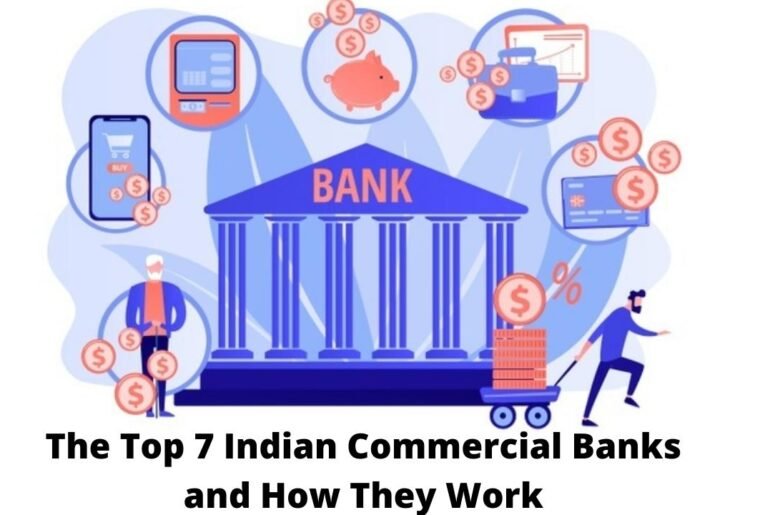The ten largest Indian commercial banks in India by assets, as determined by the Reserve Bank of India, are listed below. A commercial bank is a type of financial institution that specialises in lending to businesses and other organisations as well as providing financial services to them.
They’re also bigger than retail banks, which are more focused on individual customers. The demand for these types of financial institutions has increased significantly in India over the last decade, which can be attributed to the country’s rapid economic development.
According to statistics provided by the Reserve Bank of India, India has by far the largest number of commercial banks in the world. India has 23 public sector banks, 27 private commercial banks, and 56 regional rural banking companies, according to the International Monetary Fund (RRBs).
According to the Reserve Bank of India, the State Bank of India, which is owned by the Indian government, was the country’s largest commercial bank in terms of assets as of March 31, 2021. Examine and compare India’s top ten largest commercial banks to see how they compare to one another.
The top ten Indian commercial banks to do business with, according to the Financial Times ranking:
State Bank of India (SBI)

SBI is India’s largest bank, accounting for 23 percent of the country’s total assets and 25 percent of total loans and deposits. The State Bank of India is a government-owned financial institution with its headquarters in Mumbai, India.
State Bank of India (SBI) is India’s largest banking institution, both in terms of assets and the number of customers it serves. It has a global presence in 36 countries. It happens to be the most profitable as well. The bank’s network includes over 15,000 automated teller machines. It has nearly 30 million customers who use its online banking services, which can be accessed through the internet or a mobile application.
ICICI Bank

ICICI Bank is India’s second-largest commercial bank, after State Bank of India (Industrial Credit & Investment Corporation). KV Kamath, who served as a part-time Chairman, was a key figure in the company’s formation in 1994. The Indian headquarters of ICICI Bank are in Mumbai, Maharashtra, with the bank’s primary location in Vadodara, Gujarat.
It has subsidiaries in 18 different countries, including the United States. ICCI Bank has a 15 percent market share based on assets and a 16 percent market share based on total loans, deposits, and advances, according to the bank’s financial statements (total loans, deposits, and advances).
HDFC Bank

HDFC Bank is India’s third-largest commercial bank (Housing Development Finance Corporation). On July 22, 1977, it was founded with the mission of “providing long-term finance to individuals and businesses.” It was established in the state of California. It has its registered office in Mumbai, Maharashtra, and its corporate headquarters in Mumbai, Maharashtra. HDFC Bank is the country’s largest mortgage lender, accounting for 18% of the market by assets.
Total loans and advances account for 17% of the bank’s total assets. Among the other financial services offered by the company are investment banking (HDB Financial Services) and asset management (Housing Development Finance Corporation Asset Management Company).
Based on total assets, the bank has a 12 percent market share. HDFC Bank has over 11,000 branches and over 20,000 ATMs in India and around the world.
Kotak Mahindra Bank

Kotak Mahindra Bank, headquartered in Mumbai, is another large commercial bank in India. It was established in 1985. It has a registered office in Mumbai, Maharashtra, as well as a corporate headquarters in Pune (Maharashtra).
Total loans and advances account for 16% of the bank’s total assets. Kotak Mahindra Bank operates an investment bank (Kotak Securities) and an asset management company in addition to traditional banking services. There are more than 1800 branches in total.
As of March 31, the bank’s total market share in terms of assets in India was 12 percent, up from 11 percent the previous year.
Bank of Baroda

On the list of India’s largest commercial banks, the Bank of Baroda is ranked second. It was established in 1908 and has its registered office in Vadodara, Gujarat, where it is based (India).
Total loans and advances account for 18% of the bank’s total assets. The federal government owns all of the stock in this public-sector bank.
Bank Of Baroda, in addition to providing financial services such as investment banking through a subsidiary company based in Mumbai, also owns and operates BOB Asset Management.
Axis Bank

Axis Bank, headquartered in Mumbai, is a well-known commercial bank in India. It was established in 1994 and has its registered office in Ahmedabad, Gujarat, in the United States of America (India).
Total loans and advances account for 18% of the bank’s total assets. Axis Capital, the company’s subsidiary, offers a wide range of financial services, including investment banking. It also provides asset management services through AXIS Mutual Fund Services Limited, which is based in Mumbai and manages funds with assets worth more than Rs 23000 crore.
Axis Bank is estimated to have over 2000 branches across India. The bank’s extensive domestic and international branch network in India and abroad includes over 700 offices in 19 countries, including the United States (US), China, and Singapore.
Indusind Bank

On the list of the top commercial banks in India, Indusind Bank is ranked second. It was founded in 1999 and is headquartered in Mumbai, Maharashtra, where it also has a registered office (India). Total loans and advances account for 20% of the bank’s total assets.
Indusind Bank’s Securities division provides investment banking services with over Rs 8000 crore in funds under management. Securities is headquartered in Gurgaon and serves clients throughout the country. Another advantage for Indusind is that it is a major player in the real estate banking sector.
It has over 700 branches in 19 countries, including the United States (US), China, and Singapore, making it one of the world’s largest banks in terms of branch network in India and abroad. The bank also offers online banking services, which are available 24 hours a day, seven days a week via the Indusind Internet Banking portal or mobile app, allowing customers to transact at any time and from any location.
The above-mentioned commercial banks are the most important in India. With a sizable market share, these financial institutions compete to serve more customers and earn higher profits.
Commercial banks in India are classified into several categories.
There are three different types of commercial banks, and while a commercial bank is defined as a financial institution whose primary goal is to generate profits, there are three different types of commercial banks. These are the three types:
Public Sector Banks – Public sector banks are those that are owned by the government and provide financial services to the general public. Customers can choose from a variety of products and services, including loans for agricultural and industrial purposes, business purposes, and personal requirements.
The State Bank of India is an example of a commercial bank in India that falls under the jurisdiction of the public sector.
Private sector banks are those that are not owned by the federal government. A company owns and controls these, and the Reserve Bank of India oversees and regulates them.
ICICI Bank and Axis Bank are two of the most successful examples of private commercial banks in India.
Foreign Banks – Foreign banks are those that have their headquarters outside of India and are incorporated in a foreign jurisdiction. These banks will be able to conduct business in the country and provide their financial services to the people of India.
Bank of America is an American financial institution that has a branch in Mumbai, India. This is the most successful example of a foreign commercial bank operating in India today.
What are the methods used by Indian commercial banks to generate profits?
One of the most important ways commercial banks make money in India is by separating the interest rates charged by lenders and borrowers on loans. Please allow us to fully understand what you’re saying.
If you take out a loan from a bank, you will be charged a 14 percent interest rate. If, on the other hand, you place money in a fixed deposit, the bank will pay you 7% interest. As you can see, there is a 7% difference, which directly contributes to the bank’s profits.
As a result of this article, I hope I was able to explain what commercial banks are and provide you with a list of the top commercial banks in India.



![RBI Approved Loan Apps in India: The Best Options for Instant Loans [Updated 2024] Best Options for Instant Loans 2023](https://infoshots.in/wp-content/uploads/2023/05/RBI-Approved-Loan-Apps-in-India.png)